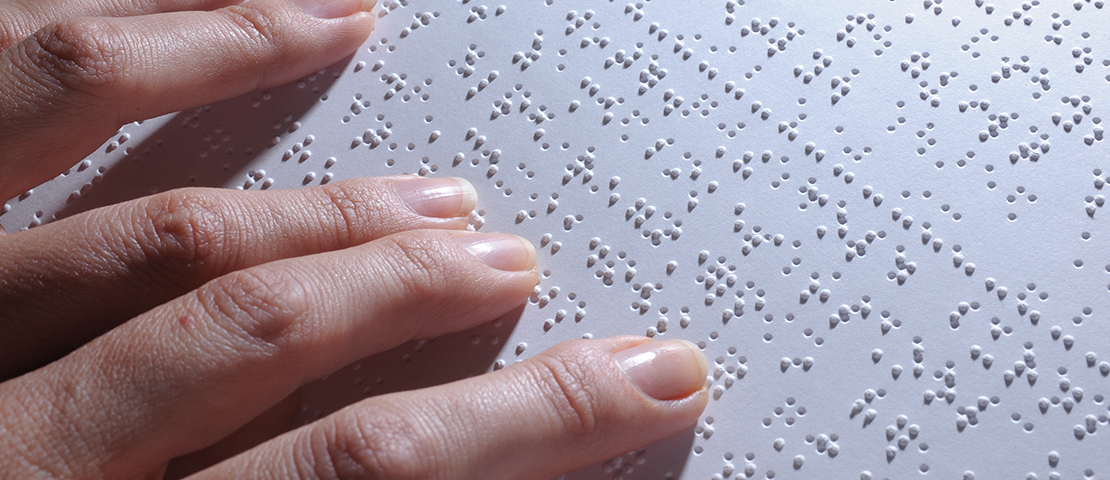The one dot on the top left represents A; the top two dots represent C, and the four dots represent 7. A person who masters the Braille alphabet can decipher any script in the world without seeing it. This is not only important from a literacy perspective, but also critical when blind people have to find their way in public spaces; it is also decisive for packaging, especially for very critical products such as pharmaceuticals. For example, today's EU regulations require these 64 different characters to be additionally marked on the packaging. But how did this innovative invention come about?
Boiled down to six dots
At the tender age of six the namesake of the world-famous characters, Louis Braille, crossed paths with a military captain in Paris. There the blind boy was introduced to “nocturnal typeface” – a system for reading made up of tactile characters. With the help of twelve dots arranged in two rows commands were conveyed to the troops in darkness. For longer texts, however, this system proved too complicated. Braille reduced the number of dots to as little as six thereby inventing today’s Braille that allows characters, mathematical equations and even sheet music to be translated into this tactile language.
The stated aim of the EU is to remove everyday barriers for the blind and visually impaired. In addition to road signs for visually impaired persons in public places such as authorities or public transport, Directive 2004/3/27 EC, in force since 2007, stipulates that the name of the medicine must be indicated in Braille on the outer packaging of medicines. The directive only excludes micro boxes of no more than 20ml and/or 20g, medicines produced in less than 7,000 units per year, registered naturopaths and medicines exclusively administered by health professionals. Upon request, pharmaceutical companies must also provide package inserts in other formats to visually impaired patients. As the most commonly used standard worldwide, the font (point) size here is "Marburg Medium".

Worthwhile extra effort
Clearly, meaningful Braille labels also have labor and cost implications. On the one hand, printers must know that not all languages have the same points. The dot combinations for %, / and full stop are different in Spain, Italy, Germany and the UK. On the other hand, printers must take into account specific dot diameters, offsets, and line spacing when imprinting or printing to ensure that Braille dots are easy to touch. However, designers here also always have to strike the right balance between function and appearance. After all, raised surfaces must not unduly interfere with readability and appearance for non-visually impaired persons.
Applying Braille to packaging is not a simple problem. Because there are different requirements for the embossing of the braille: For the best optical effect, the embossing of the braille should be weak so that the cardboard material does not tear. The higher the degree of embossing, the greater the risk of tearing the cardboard cover. For blind people, on the other hand, some minimum height of braille dots is necessary so they can feel the text easily with their fingers. Therefore, applying embossed dots to packaging always represents a balancing act between appealing visuals and good readability for the blind.
Digital printing makes application easier
Until a few years ago, Braille was still imprinted, for which a corresponding imprinting tool had to be produced. Then, screen printing was introduced - thanks to this initial evolution, the industry only needed a screen-printed stencil. But the real revolution will only come with digital printing. Now, braille dots are just a matter of ink jet printing and varnish.
However, this is not easy: prerequisites include good nozzle flow rates and ideal drying properties, as well as high-speed printing. In addition to this, ink jets must meet minimum size requirements, have good adhesion and be free of fog. Therefore, the selection of printing inks/varnishes requires a great deal of experience, which is now acquired by many companies in the industry.
There are occasional calls to remove the mandatory application of Braille on selected packaging. Some say these costs can be saved with electronic tags, arguing that it also allows users who know neither letters nor Braille, such as elderly people who have been visually impaired for years, to get the information they want.
End
So far, Braille packaging still has many problems waiting for us to solve, we will do our best to make better Braille packaging for the people who need it.Thank you for reading!
Post time: Jun-10-2022










